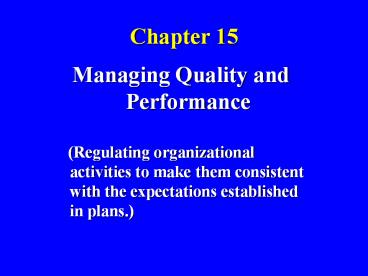Managing Quality and Performance - PowerPoint PPT Presentation
1 / 9
Title:
Managing Quality and Performance
Description:
Decentralized (Clan) Control. Organic, Emphasizes Internal Control. Based on Corporate Culture ... Requires more Decentralized (Clan) control than traditional approach ... – PowerPoint PPT presentation
Number of Views:96
Avg rating:3.0/5.0
Title: Managing Quality and Performance
1
Chapter 15
- Managing Quality and Performance
- (Regulating organizational activities to make
them consistent with the expectations established
in plans.)
2
Organizational Control Focus
Feedforward Control Focuses on quality
of resources acquired by organization
(inputs) (Selecting Locations, Training
Franchisees)
Outputs
Production
3
Organizational Control Focus
Concurrent Control Focuses on quality of task
activities to transform inputs into
outputs (Detailing Operating Procedures and
monitoring them during food preparation)
Outputs
Inputs
4
Organizational Control Focus
Feedback Control Focuses on quality of product
and service outcomes (Customer surveys, sales
analyses)
Inputs
Production
5
Steps in the Control Process
4. Take corrective action
Feedback
Adjust Performance
Adjust Standards
If Inadequate
Establish Strategic Goals
1. Establish standards of performance
2. Measure actual performance
3. Compare performance to standards
If Adequate
4. Do nothing or provide reinforcement
Feedback
6
Traditional Bureaucratic Control
- Mechanistic, Emphasizes External Control
- Rules and procedures
- Hierarchy of authority
- Quality Control Department
- Technology
- Extrinsic Rewards
7
Decentralized (Clan) Control
- Organic, Emphasizes Internal Control
- Based on Corporate Culture
- Implemented by
- - Peer groups
- - Self-control
- - Empl. selection and socialization
- Increasingly necessary with Downsizing
- Both Extrinsic and Intrinsic Rewards
8
Total Quality Management
- A philosophy of organization-wide commitment to
continuous improvement - Focuses on teamwork, customer satisfaction,
preventing defects, and lowering costs - Requires more Decentralized (Clan) control than
traditional approach - Gives workers responsibility for achieving
standards of quality - Workers are trained in TQM and rewarded for
quality improvements - TQM enriches jobs and motivates
9
TQM Techniques
- Most companies that have adopted TQM have
incorporated. - Quality circles.
- Benchmarking.
- Six sigma principles.
- Standard for reduced cycle time.
- Continuous improvement.































